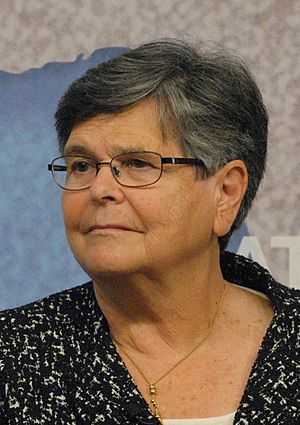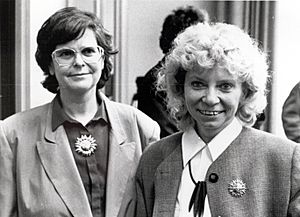Ruth Dreifuss facts for kids
Quick facts for kids
Ruth Dreifuss
|
|
|---|---|

Dreifuss in 2014
|
|
| President of Switzerland | |
| In office 1 January 1999 – 31 December 1999 |
|
| Vice President | Adolf Ogi |
| Preceded by | Flavio Cotti |
| Succeeded by | Adolf Ogi |
| Vice President of Switzerland | |
| In office 1 January 1998 – 31 December 1998 |
|
| President | Flavio Cotti |
| Preceded by | Flavio Cotti |
| Succeeded by | Adolf Ogi |
| Minister of Home Affairs | |
| In office 10 March 1993 – 31 December 2002 |
|
| Preceded by | Flavio Cotti |
| Succeeded by | Pascal Couchepin |
| Member of the Federal Council | |
| In office 1 April 1993 – 31 December 2002 |
|
| Preceded by | René Felber |
| Succeeded by | Micheline Calmy-Rey |
| Personal details | |
| Born | 9 January 1940 St. Gallen, Switzerland |
| Political party | Social Democratic Party |
| Alma mater | University of Geneva |
Ruth Dreifuss, born on January 9, 1940, is a well-known Swiss economist and politician. She was a member of the Swiss Federal Council from 1993 to 2002. This council is like the government of Switzerland. She also made history by becoming the President of Switzerland in 1999. She was part of the Social Democratic Party.
Contents
Early Life and Education
Ruth Dreifuss was born on January 9, 1940, in St. Gallen, Switzerland. She was the second child of Sidney Dreifuss, a merchant, and Jeanne Bicard, a secretary. Her family moved to Geneva in 1945.
Ruth attended school in Geneva and later a commercial school. She then studied social studies and economics. In 1970, when she was 30 years old, she earned a Master of Arts degree in Economics from the University of Geneva.
Career Beginnings
After finishing her business education, Ruth Dreifuss worked as a secretary and a social worker. She also worked as a journalist for a newspaper called Cooperation from 1961 to 1964. In 1964, she joined the Socialist Party (SP).
From 1972 to 1981, she was a scientific expert for the Swiss Agency for Development and Cooperation. She also became the Secretary of the Swiss Trade Union. In this role, she focused on important topics like social insurance, laws about work, and issues affecting women. She continued this work until she was elected to the Federal Council in 1993.
Entering Politics
Ruth Dreifuss was a member of the City of Bern's Legislative Assembly from 1989 to 1992. This assembly helps make laws for the city.
She is also a member of the Council of Women World Leaders. This is a group of current and former female leaders from around the world. Their goal is to work together on important issues for women and fair development.
Election to the Federal Council
When René Felber resigned from the Federal Council, it was expected that another member from the Social Democratic Party would be chosen. This was based on an unofficial rule called the "magic formula" for how parties are represented in the government.
The Social Democratic Party first suggested Christiane Brunner for the election on March 3, 1993. However, some other parties supported a different candidate, Francis Matthey. He was also from the Social Democratic Party. But Francis Matthey decided not to accept the election because his own party did not support him for that specific vote.
A new election was held on March 10, 1993. This time, the Social Democratic Party put forward both Ruth Dreifuss and Christiane Brunner as their official candidates. It was the first time that two women were officially nominated together for this important election. Ruth Dreifuss was elected in the third round of voting with 144 votes.
Key Political Actions
Ruth Dreifuss was in charge of the Federal Department of Home Affairs until she resigned on December 31, 2002. She made history again by becoming the first woman ever to be elected President of the Confederation. She served as president from January 1 to December 31, 1999.
During her time in office, she helped pass several important laws. These included changes to the Health Insurance Bill and the social security system. She also supported a new approach to drug policy. This policy focused on four main areas: prevention, treatment, help, and rehabilitation. This "4-pillar policy" also aimed to reduce the spread of diseases like AIDS, partly by providing clean syringes.
She also worked on a law for Maternity Insurance. However, the majority of the Federal Council did not agree with her proposal. Because of this, she had to ask the public to vote against her own text. This showed her commitment to the rule of collegiality, where all members of the council support the final decision.
Ruth Dreifuss is currently a member and former leader of the Global Commission on Drug Policy. She is also a member of the International Commission Against the Death Penalty.
See also
 In Spanish: Ruth Dreifuss para niños
In Spanish: Ruth Dreifuss para niños



